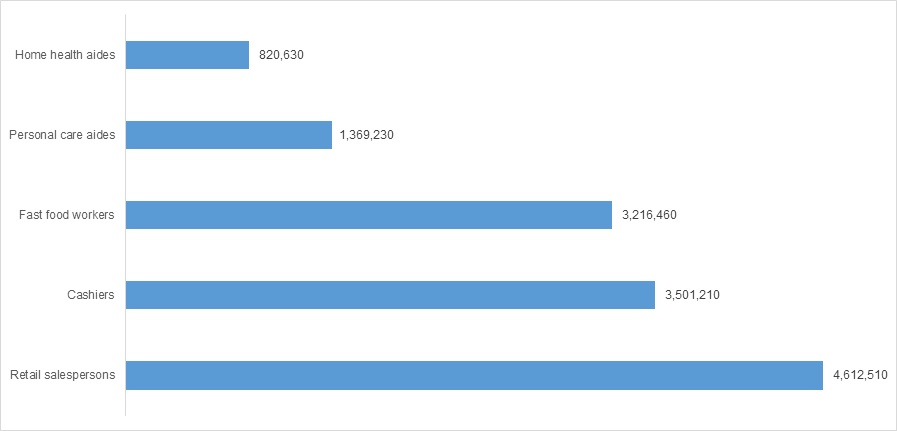 Shortage of paid care workers – a growing problem, not well-quantified by region. As AARP predicted in 2013, by the time the boomers arrive in their 80’s, just nine years from now, there would be a population deficit of prospective care providers aged 46-64 – the caregiver support ratio (CSR). But perhaps the more intriguing question – where are the workers who could, should, or would provide care? In a study released in December 2015, the U.S. Bureau of Labor Statistics (BLS) stated that the compound annual growth rate for home care services, particularly personal care aides, between 2014 and 2024 would be nearly five percent, the highest among all industries. Compare the number of workers that provide direct care (for example, personal care aides) to retail – these jobs are low-paying at approximately $11/hour and most would say the work is physically more difficult than other low-paying categories. And tech-enabling the care, while streamlining sourcing and tracking, does not close the available labor gap.
Shortage of paid care workers – a growing problem, not well-quantified by region. As AARP predicted in 2013, by the time the boomers arrive in their 80’s, just nine years from now, there would be a population deficit of prospective care providers aged 46-64 – the caregiver support ratio (CSR). But perhaps the more intriguing question – where are the workers who could, should, or would provide care? In a study released in December 2015, the U.S. Bureau of Labor Statistics (BLS) stated that the compound annual growth rate for home care services, particularly personal care aides, between 2014 and 2024 would be nearly five percent, the highest among all industries. Compare the number of workers that provide direct care (for example, personal care aides) to retail – these jobs are low-paying at approximately $11/hour and most would say the work is physically more difficult than other low-paying categories. And tech-enabling the care, while streamlining sourcing and tracking, does not close the available labor gap.
What is that gap – and is it well-understood? Take a closer look at the BLS graph, for the official worker counts home care aides and home health aides, the numbers in each are not encouraging:

What is the actual ratio of prospective clients to available workers – by geography? The only way to evaluate that gap is examine the individual county data from the census, comparing the population aged 80+, which is the prospective client base, to actual workers in care delivery job codes. The highest number of prospective clients as compared to the number of workers in individual job codes is the Paid Caregiver Support Ratio – or pCSR. First examine the data from the 2015 blog post Stranded by Geography, which was based on the age ratio of prospective caregivers to baby boomers aged 80+. Now look at this county data about personal care aide workers (see attached PDFs), which shows a gap between the prospective number of aged 80+ seniors per care worker. This gap is very noticeable in Florida and New Jersey. Future postings about the pCSR will examine other job categories that provide care, including home health aides, examining the gap in those categories.

 Shortage of paid care workers – a growing problem, not well-quantified by region. As AARP predicted in 2013, by the time the boomers arrive in their 80’s, just nine years from now, there would be a population deficit of
Shortage of paid care workers – a growing problem, not well-quantified by region. As AARP predicted in 2013, by the time the boomers arrive in their 80’s, just nine years from now, there would be a population deficit of 
Comments
From Rob McClenahan via LinkedIn
In retrospect, the necessity of understanding the "pCSR {paid caregiver support ratio}" is important for all healthcare stakeholders, so thank you for sharing this resourceful “Aging in Place Technology Watch” article with our group.
When considering variances in aging populations by county compared to the availability of caregivers on hand, immense geographic variances can occur when making a statistical comparative analysis of this data.
To date, the challenge of reducing the ratio to a workable number could be the biggest challenge in the home care industry today, so this will be an intriguing to topic to follow. Nice read!
From Peg Graham via LinkedIn
SOO glad you are focusing on this important issue.
Add the expected gap between supply and demand for FAMILY caregivers (See http://www.prb.org/Publications/Reports/2016/todays-research-aging-caregiving.aspx)
The work of Emily Agree and Vicki Friedmen on the interdependent relationships between personal assistance, assistive equipment and behavioral adaptations provides importance insights into the full array of variables that need to be considered as we grapple with the truly daunting challenge of supporting older adults aging at home, with and without disability.
See Skolarus, The Role of Accomodations in Post-Stroke Management, available at https://www.ncbi.nlm.nih.gov/pmc/articles/PMC4303064/pdf/gbu117.pdf
Robotics Value For Aging In Place
Laurie – incredibly important topic. I believe that robotics will actually become an enormous area of innovation, investment and ultimately solutions for this issue. We may not achieve full function robots in our lifetime, but assistive robotic devices will definitely come into play e.g. lifting, moving, fetching and delivering stuff, providing interactive telemedicine (and enhanced communication of all kinds), etc. The list is endless. Japan leads, driven by their population issues, which in terms of aging and lack of individuals to help, dwarf our own. But other nations are catching up. https://www.nytimes.com/2015/12/08/science/as-aging-population-grows-so-...
Being able to remain in the
Being able to remain in the comfort of your home when you reach old age is probably very important to you. However, it can be a difficult thing to achieve if you are ill or non-mobile. Thankfully, home health care Houston is a safe and comfortable option that allows you to maintain your independence.
Home health care
Hi Sam Billing,
I'm very thankful to you about telling us very good info about home health care. Actually, i want to know about the agency where it is located in Houston, TX. If it is possible please tell me the address or website.
Home Health Care
Hey, Christoper!
Thanks for taking interest in home health care. Here is the website address as you asked me for that https://www.yourefirst.net/